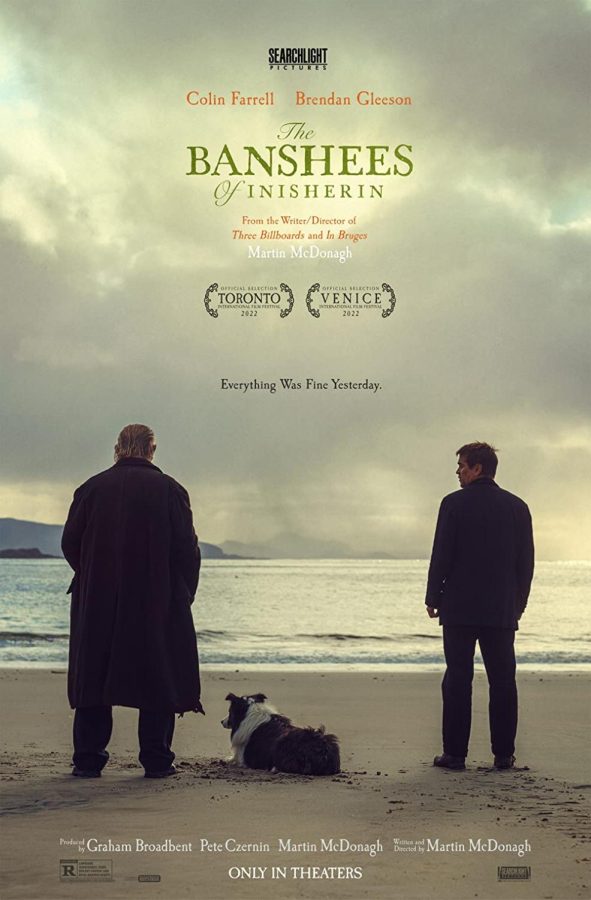“The Banshees of Inisherin” review: A reflection on morality under civil divide
February 10, 2023
With three Golden Globe wins and nine Oscar nominations under its belt, “The Banshees of Inisherin” has taken this year’s award season by enviable storm, and for good reason. Writer and director Martin McDonagh, most notably the mind behind “Three Billboards Outside Ebbing, Missouri” and “In Bruges,” does another fine job of worldbuilding in his newest incarnation. The film has been met by viewers and reviewers with much-deserved acclaim and positive buzz due to its performances, writing, and directing.
But it’s the story that resonates and raises thought-provoking questions that are not always easily answered. Who are we and what are we defined by? What is the real reason behind divisions and discourse? What is the most worthwhile use of the limited time we have left? These questions percolate throughout the film and are part of the lasting residue it leaves you to explore.
“The Banshees of Inisherin” is a political contemplation at heart, told through the lens of a small town off the Irish mainland, and more closely, two of its “rowing” residents. Set on the island of Inisherin in 1923’s Ireland, the film features Colm Doherty (Brendan Gleeson) and Pádraic Súilleabháin (Colin Farrell).
Pádraic is on his way to grab Colm for their daily trip to the local pub when his knocks meet no answer. He leaves ignored and confused. From this moment on, there is a noticeable and irreversible change in the dynamic of their relationship and it causes both to spiral. They begin fighting a war, and neither knows exactly why. Little wars are being fought all across Ireland’s surface: some just over on the mainland, others between friends on the isolated island of Inisherin.
The cast is next level. Gleeson and Farrell reunite after joining ranks in McDonagh’s earlier “In Bruges.” Farrell plays the relentless and oblivious Pádraic. His rash decision-making gives the film its momentum. Farrell weaves flare and hurt into his performance, with every look and through every line delivery. Burrowing away in his simple seaside home, Gleeson’s portrayal of Colm tirelessly works to create art that will outlive him on his reclusive journey toward legacy. Gleeson is known for his exhausted, aging, and frustrated characters and he draws a lot of his performance from that same place for his Colm.
Kerry Condon and Barry Keoghan make for very strong support. Keoghan dances with intention and flaunts his impeccable control as an actor. The sheer amount of choices he makes in a single scene as Dominic Kearney, denoting unabating discomfort as the result of an abusive home life, is beautifully painted and painfully subtle. Kerry Condon yields a seasoned and grounded contrast to Farrell’s portrayal of Pádraic. Both add a much-needed presence to the otherwise bleak feature.
Relatability is an important factor of Banshees. Some may connect with Colm’s attempt at ending an unfulfilling friendship the only way he knows how, or others with Pádraic’s undeserved and sudden ostracism. It is easy to find yourself in one of the four leads. Every good story contains either a character the audience can see themselves in or a feeling they can resonate with. Film validates and restates the human experience.
Quick, dark humor lightens the blow of McDonagh’s powerful story. The storytelling feels fresh and direct, evocative of a splash of cold water that leaves you a little numb but revitalized. The mythology-based title “The Banshees of Inisherin,” the name of the song Colm is working to complete, suggests it follows the formula of a fable, myth, or parable, but somehow is wholly original in its delivery.
The story draws the most influence from the Irish civil war at the time the film is set. Its political influence is integrated throughout the story, but is not the glaring centerpiece of the conflict. It is told mostly through metaphor, passing comments, and subtleties, such as the recurring shots of far-off cannon fire along the mainland. Our two central characters represent the deep political divide that drove Irish families, friends, and neighbors to cut each other loose and throw punches at every opportunity.
The Irish War of Independence led directly to the conflict of the Irish civil war over the signing of the Anglo-Irish Treaty, which developed into even more ensuing strife, bloodshed, and vast warfare for the already-exhausted Irish people. In “The Banshees of Inisherin,” we focus on a small island and its small drama, out of a big country and its big civil war. This small story is instrumental in retelling the experiences of those who suffered at the hands of the war through a portrait of those invisible people that help to personalize it. “The Banshees of Inisherin” allows us to make visible the invisible, so that we can personalize, understand, and ultimately empathize.
“The Banshees of Inisherin” is now available on HBO Max.









